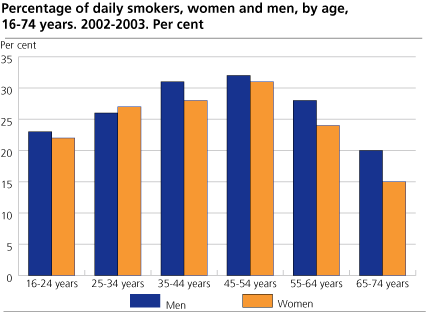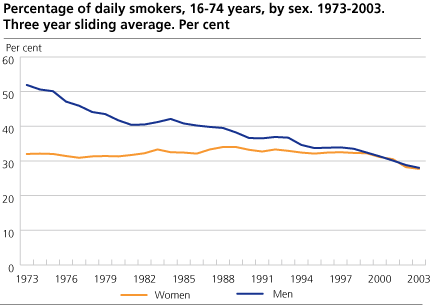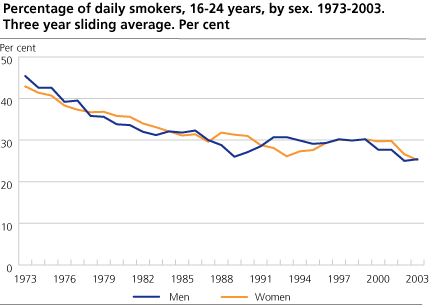Content
Published:
This is an archived release.
Fewer Norwegians smoke
About one out of four or a good 26 per cent of the Norwegian population aged 16 to 74 smoked daily in 2003. More than one out of ten smoked occasionally. In 2002, 29 per cent smoked every day.
Every year Statistics Norway conducts surveys on the use of tobacco. The surveys from 2003 reveal that 26.3 per cent of the population aged 16-74 smokes daily. The corresponding figure in 2002 was 29.4 per cent.
The trend is most pronounced among women, with a fall in daily smoking from 30.0 to 25.3 per cent. The corresponding figures for men are 28.8 and 27.2 per cent, however, this is not a significant decline. Smoking is most common in the age group 35-54 years and lowest in the youngest and oldest age groups (figure 1).
Decline among the youngest?
In the youngest age group (16-74 years) the proportion of daily smokers has gone down from 27.8 to 22.8 per cent, a sharp decline that becomes even more apparent when figures for those who smoke every day and those who smoke occasionally are combined. For this group the decline is 7 percentage points, which is a significant increase in the proportion of non-smokers.
Fewer smokers among both men and women after 1998
In 1973 more than half of the male population (51 per cent) were smokers. Today the figure is approximately 29 per cent. In the period 1973 to 2000 more than 30 per cent of women smoked every day, a figure that is now down at 25 per cent. The gender difference that was so apparent in the 1970s is now gone.
A change in smoking patterns seems to have occurred around 1998. Since then there has been a marked decline in the proportion of smokers, both among men and women. This pattern also holds for 16-24 year olds (figure 3).
About the survey
Statistics Norway has conducted surveys on the use of tobacco for thirty years. The proportion of smokers is measured by two questions: "Do you sometimes smoke?" and "Do you smoke daily or occasionally?" In the course of one year four Omnibus surveys with a total net sample of 5 000 people are carried out.
There are possible sources of error in any interview survey. Therefore, error margins of more than one percentage points both ways are used in the surveys. To counteract the effect of random changes in the data, especially in diagrams such as figure 2 and 3, a three-year moving average is used. This is particularly important in those periods where the sample has been smaller than what it is today. A three-year moving average means that the average of the results for three consecutive years is calculated, and that this average represents the second year. Table 1 shows the effect of this method.
|
Percentage daily smokers, by age. 1994-2003.
Observed result and estimated three-year sliding average |
| Daily smoker 16-74 years | Daily smoker 16-24 years | ||||||||||||||||||||||||||||||||||||||
|---|---|---|---|---|---|---|---|---|---|---|---|---|---|---|---|---|---|---|---|---|---|---|---|---|---|---|---|---|---|---|---|---|---|---|---|---|---|---|---|
| Year |
Observed
result |
Estimated
three year sliding average |
Sample
size (N) |
Observed
result |
Estimated three
year sliding average |
Sample
size (N) |
|||||||||||||||||||||||||||||||||
| 1994 | 33.0 | 34.0 | 1 870 | 27.0 | 29.0 | 338 | |||||||||||||||||||||||||||||||||
| 1995 | 33.0 | 33.0 | 5 165 | 29.0 | 28.0 | 812 | |||||||||||||||||||||||||||||||||
| 1996 | 33.0 | 33.0 | 5 189 | 29.0 | 29.0 | 854 | |||||||||||||||||||||||||||||||||
| 1997 | 34.0 | 33.0 | 5 305 | 31.0 | 30.0 | 819 | |||||||||||||||||||||||||||||||||
| 1998 | 33.0 | 33.0 | 5 088 | 31.0 | 30.0 | 797 | |||||||||||||||||||||||||||||||||
| 1999 | 32.0 | 32.0 | 4 913 | 28.0 | 30.0 | 783 | |||||||||||||||||||||||||||||||||
| 2000 | 32.0 | 31.0 | 5 004 | 32.0 | 29.0 | 806 | |||||||||||||||||||||||||||||||||
| 2001 | 30.0 | 30.0 | 5 047 | 27.0 | 29.0 | 781 | |||||||||||||||||||||||||||||||||
| 2002 | 29.0 | 29.0 | 5 311 | 28.0 | 26.0 | 819 | |||||||||||||||||||||||||||||||||
| 2003 | 26.0 | 128.0 | 5 094 | 23.0 | 125.3 | 812 | |||||||||||||||||||||||||||||||||
| 1 | Average 2002 and 2003. |
The statistics are produced every year on behalf of the Directorate for Health and Social Affairs.
Tables:
Contact
-
Elin Skretting Lunde
E-mail: elin.skretting.lunde@ssb.no
tel.: (+47) 92 42 70 07
-
Jorun Ramm
E-mail: jorun.ramm@ssb.no
tel.: (+47) 92 08 23 99
-
Arne Jensen
E-mail: arne.jensen@ssb.no
tel.: (+47) 99 71 22 45



